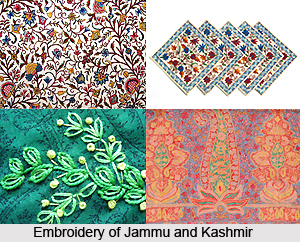Embroidery of Jammu and Kashmir is known for their unique artistry they have been following for decades. The embroidery, that is the pride of the state, is famous not only in India but all over the world for its excellent selection of materials.
Embroidery of Jammu and Kashmir comprises the Kashmiri crewelwork or Chain stitch. This stitch is favoured for its exclusive crewel embroidery which is employed to make the wall hangings and rugs. The Kashmiri artisans create different items following the practice of Chain stitch. This is done by hook rather than needles on white backgrounds with wool, silk or cotton. This embroidery is more popular in this state than any other kinds of needle work. The artisans illustrate their ideas from the landscape and the surrounding beauty that prevail in the vicinity. The main patterns that are incorporated by the artisans in their creations include motifs of chinar leaves, cypress cones, the lotus and almonds.
 Embroidery of Jammu and Kashmir is also known for the Kashida style of embroidery. This style of Kashmiri embroidery has a wide variation and is created with a rich variety of colours with exquisite designs. This is created by the artisans on shawls or saris and the created items are good to look at from both sides. Sometimes sujni stitch is also employed for creating exclusive designs on shawls. The embroidery of Jammu and Kashmir includes a number of stitches that are used to create different designs on the base materials. Vata-chikan is a buttonhole stitch for thick fillings. Another type of embroidery work that is extensively used in Jammu and Kashmir is the Amli embroidery where threads of various colours are used and this stitch is done on kani shawls. Do-rookha is a double-sided stitch, used to create similar patterns on either side with different colour combinations. Small stitches are also used to fill the entire area of the item. The figures or motifs are added extra glitz by using striking colors. Cotton based crewel art pieces make excellent household furnishings and are hand or machine washable. Jammu and Kashmir is also famed for its style of embroidery created on different items like phiran, tapestry, curtains, shawls and household linen.
Embroidery of Jammu and Kashmir is also known for the Kashida style of embroidery. This style of Kashmiri embroidery has a wide variation and is created with a rich variety of colours with exquisite designs. This is created by the artisans on shawls or saris and the created items are good to look at from both sides. Sometimes sujni stitch is also employed for creating exclusive designs on shawls. The embroidery of Jammu and Kashmir includes a number of stitches that are used to create different designs on the base materials. Vata-chikan is a buttonhole stitch for thick fillings. Another type of embroidery work that is extensively used in Jammu and Kashmir is the Amli embroidery where threads of various colours are used and this stitch is done on kani shawls. Do-rookha is a double-sided stitch, used to create similar patterns on either side with different colour combinations. Small stitches are also used to fill the entire area of the item. The figures or motifs are added extra glitz by using striking colors. Cotton based crewel art pieces make excellent household furnishings and are hand or machine washable. Jammu and Kashmir is also famed for its style of embroidery created on different items like phiran, tapestry, curtains, shawls and household linen.
Embroidery of Jammu and Kashmir includes gold or silver embroidery which gives the created items an added sheen. This embroidery is done around the necks of gown or `phirans`. The people of Jammu and Kashmir use a typical floor covering which is made out of old blankets with a combination of appliqué work and chain stitches. These embroidered and appliquéd floor coverings are named as `gabbas` by the local people. The `namdha` are created from beaten wool and are embroidered all over the item. The chain-stitch rug, made from Hessian cloth and coarse wool, over which floral and other motifs are worked are also famous among the local people and the people who come to visit this place as well. The patterns in `gabbas` and `namdhas` are done in floral and geometrical designs.
Embroidered shawls of Jammu and Kashmir reflect the artistry and creativity prevalent in the state. The famous Pashmina shawls which are the hallmark of the embroidery of Jammu and Kashmir are embellished with fine silk thread. The fabric of this shawl is derived from the smooth brushed wool of Kel goat by the handloom artisans who are usually womenfolk. Another popular shawl made in Jammu and Kashmir is the `ring shawl`. The shawl has earned the name of `ring shawl` for the smoothness of the material that can pass effortlessly through a ring. The artisans of Jammu and Kashmir create a rare and different type of shawl that is famous as Jamavar shawl in the different regions of India. The charm and excellence of this famous shawl is bestowed by the brilliant use of coloured yarn and life like designs that are taken from the architectural and mythological backgrounds of this state.
The embroidery of Jammu and Kashmir is remembered for the exquisite creativity that is defined in the items created by the local artisans. The decency and elegance radiate from the creations are typical of the tradition and culture of the land.






